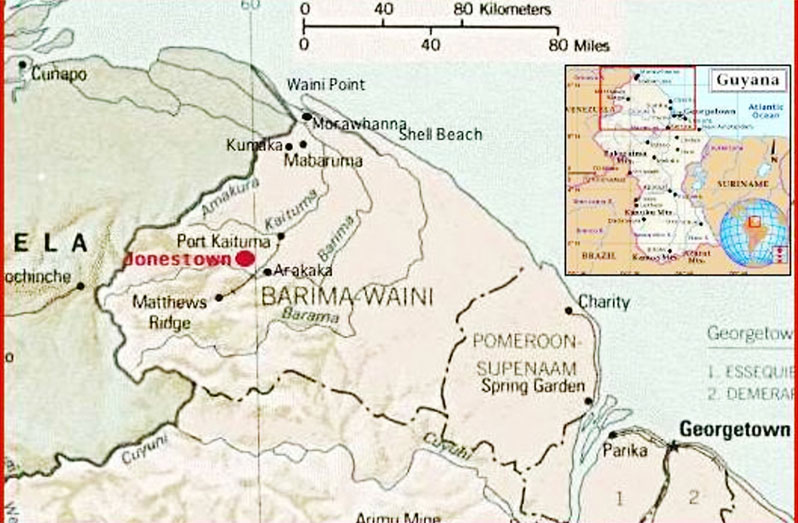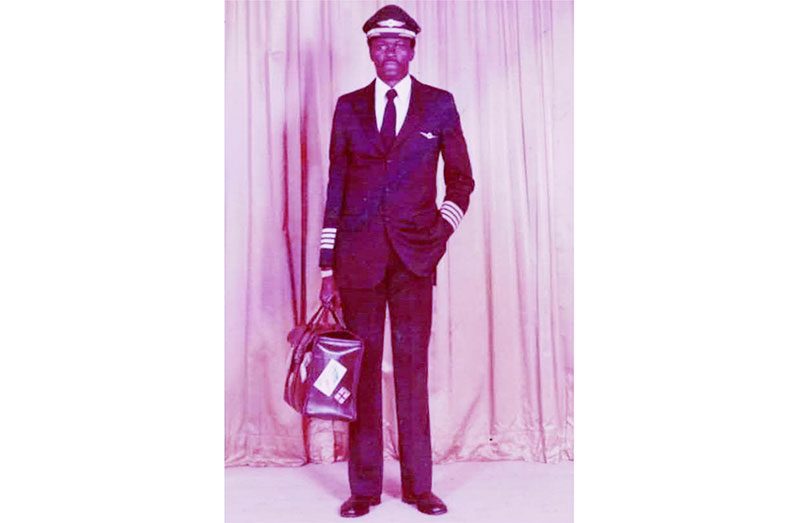(Loop Caribbean News) THE “Jonestown tragedy” has been defined by so many different “spins.” Most of these “spins” as well as factual narratives focused on the man known as the “charismatic preacher” Jim Jones, an American and many of the Americans who survived or escaped “Jonestown”, which was set in Port Kaituma in Region One.
Jones and the murder of some 900 people, including children, would be the focus of yet another movie with actor Leonardo DeCaprio playing Jones. After all, this was an American tragedy on Guyana’s soil.
Resisting the urge for a spin is retired pilot Captain Rodwell Astill Paul. Paul along with Captain Guy Spence arrived at the airstrip in Port Kaituma on November 18, 1978 to transport US Congressman Leo Ryan back to Georgetown. Ryan had visited Guyana, and the Peoples Temple in particular, to meet with Jones and many of the Americans who we would later learn wanted to defect and leave the Peoples Temple and Guyana altogether.
Loop Caribbean met Captain Paul at his Georgetown, Guyana home. There, he told us, he hardly ever talks about his “brush with death”. In fact, when Captain Paul got back to the city on the night of November 18, 1978, he never told his wife or sisters that he almost lost his life.
Recounting a call with his wife, Captain Paul said she had asked where he was, “but you don’t fly so late”, Captain Paul told us, his wife stated to him.
“I said I had something to do, I did not tell anybody,” he told us. Nobody knew that earlier that day he dodged bullets on an airstrip in a remote location in Guyana’s hinterland nor that he was in a plane that nearly landed on a busy street.

In 2015, his son, Rotimi Paul wrote that his father’s connection to Jonestown was a mystery to the family, “My trips with him into the interior provided the perfect opportunity to sit in the cockpit and hear stories about his aviation — the people, the place, the place, the perils and the humour that accounted for the many entries in his logbook,” the young Paul wrote on an online blog titled, ‘Alternative Considerations of Jonestown and Peoples Temple’.
“Though we would have many many chats like this over the years, one topic he never mentioned was the one with his connection to the Jonestown story,” Paul wrote.
Captain Paul’s trips to these hinterland locations were many at the time and there were routine things that he would do once the plane had landed. This time, he accompanied Chief Pilot Guy Spence to Kaituma Airstrip where Congressman Ryan and his assistant Jackie Speier were expected to meet the plane. Captain Paul said the first unusual thing he noticed was that a large group of persons were being transported towards the plane, a Twin Otter. “I could not understand why, there is a system where we have to know how many people were coming on the plane,” he said.
Captain Paul said from the aircraft he saw a tractor with a trailer also approaching the airstrip. By that time, he was making his way to meet Speier outside the aircraft for the list of persons who were expected to board the flight.
“The shooting started,” Captain Paul said. “These guys were shooting from the trailer.” Captain Paul was already outside the plane when he noticed members of a foreign television crew who were still filming and some other people who he said were getting close to the propeller of the plane. He had gone to stop them from walking close to the plane, “They were sort of walking backwards into the propeller, this is where I was caught with the gunfire.”
Captain Paul said upon hearing the gunshots he started to run. He had seen a house close to the airstrip and thought he would make his way there. “But then I thought I was too exposed.” So he ran back to where the television crew was. “As I was going back I was talking to them saying somebody is shooting as I looked at the side, the guy with the camera, he was not there, but they were shot and they have now fallen,” he recounted, “I now lay down there among them, I was able to go and lie down with the reporters, lie down among them and hoping for the best.”
His refuge among the dead and injured would be short-lived as he recalled hearing continuous gunshots. He said he thought the gunmen would have ignored those already laying on the ground but after hearing the gunshots, he made a sprint towards the house he saw by the airstrip.
Captain Paul would then lay wait by some bushes but those provided little cover. A truck parked on the airstrip seemed a viable option and on his way to the truck, he saw a Guyana Defence Force plane and made his way in its direction.
Interestingly, the truck was on the airstrip for a reason. Captain Paul explained that it was later learnt that gunmen were expected to use the truck to shoot down the plane with the Congressman and others once it left the airstrip, thereby creating a story that there was an accident and Jonestown would go on.
By the time Captain Paul got towards the GDF plane, the soldiers were making their way towards a muddy ditch, where they all took cover. All of this happened within minutes and by the time the shooting had stopped, it was time to assess what had taken place. Captain Paul said he knew nothing was amiss in Jonestown nor what led to the shooting. He would make his way back to his plane where the chief pilot, Captain Spence, had secured himself on the floor of the plane.
LEAVING PORT KAITUMA
Getting the Twin Otter started was another task. Captain Paul explained that the right engine of the plane “was not firing,” a bullet had passed through the fuel control unit, he explained. There were people on that plane and Captain Paul said he asked them to disembark. But one woman would not budge, he said.
“I looked from the cockpit and said, ‘Madam, kindly exit the aircraft’. I came out the seat and touched her, no response – I looked at her she was just really sitting there, but she was obviously dead,” Captain Paul recounted.
He would spend the next few minutes tending to the injured, he told us, praising his Boy Scouts training. He had used his T-shirt to stop bleeding and sent to purchase two bottles of rum, the alcohol would be used to treat the gunshot wounds. It was that rum that was used to treat the injured Congressman’s assistant and Monica Bagby who was shot in her back and had to be flown to the city with Captain Paul.
Another plane sat on the airstrip. Its pilot was Tommy Fernandes. Captain Paul said that based on information he found out later, both planes were expected to fly defectors back to Georgetown.
Captain Paul and Fernandes, the pilot in command along with Captain Spence would leave Port Kaituma for Georgetown in the aftermath of the shooting. Along with them was a flight hand, identified as Glasgow, and the injured Monica Bagby. Captain Paul recalled “sapping” Bagby’s back which was then “rising like bread” with the alcohol as he was crouched behind Captain Spence’s seat on the right of the plane.
The shooting, while a scary experience, was not as half as scary as the almost landing of the plane on the main highway close to the Essequibo River. Captain Paul recalled the plane making its way over the Essequibo River, he would look down and noted Hogg Island, “I was born in Essequibo, so I know,” he declared, “I noticed the aircraft coming down, I said, ‘Tommy where you going?’ He said that is Timehri, I said that is not Timehri, what you telling me.”
The plane was due to land at Guyana’s then lone international airport, Timheri.
“I said, ‘Captain Spence, we got a lil problem here’. He looked up and said, ‘Oh s**t Tommy, that is not Timehri’,” Captain Paul recounted as he said they would have all died if the plane got dangerously close to landing.
Guyana and the world would learn about the massacre two days after. Cyanide-laced Kool-Aid was fed to Jones’ worshippers; those who refused were injected with cyanide or shot.
Captain Paul said on his way to the city, as he made his way home and even the following day, he was unaware of this mass murder. By that Monday, as the news made its way around, it was only then that it hit Captain Paul that this was a major tragedy.
Captain Paul along with Captain Marshal flew over Jonestown that Monday. “We passed the place, I saw the stuff but the time we were supposed to be at Port Kaituma and Jonestown and I looked down and said we should be here, I am looking down and seeing all these colours,” he called, “I am seeing this is the place, these are the people, as you are looking you are seeing dresses, shorts, just a colour array of bodies.”
“ONLY THOSE TWO THINGS JAR ME”
Captain Paul said he has never allowed the Jonestown tragedy to define his life or his contribution to the aviation sector. “I don’t think about it at all, I have gone past Jonestown,” he said.
But two incidents “jar” him, he told us, one was the near landing of the plane in Parika and the other…
Captain Paul said he had gone to the airport to collect a package, a few days before the incident. While at the airport, he saw an elderly woman with two children between the ages of 12 and 16. The woman was crying, he recounted. “She said she came to worship with Brother Jim but was not being allowed into the country.”
Apparently, the woman could not complete the immigration forms and Captain Paul said he proceeded to assist them. “Now as I am saying this, I think my problem with the whole of Jonestown, if I had left that woman at the airport and immigration had sent her back to California, she and the two children would have been alive, well I mean the children would have been alive now. Here, I was just being a good samaritan,” he said followed by a loud sigh.
Captain Paul said that he has given his son Rotimi his plane logs as well as any other material on Jonestown. He ponders telling more of his story and said he and his son have discussed doing a documentary on his experience.



.jpg)








